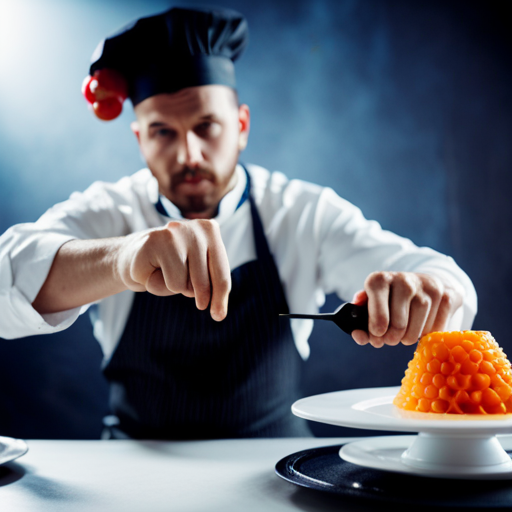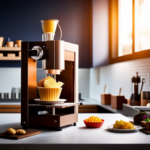In the dynamic world of culinary arts, the convergence of molecular gastronomy and 3D food printing represents a groundbreaking fusion of science and gastronomy. This innovative alliance is reshaping the way we conceptualize and create food, pushing the boundaries of culinary creativity and technological advancement.
By marrying the precision of molecular gastronomy with the cutting-edge capabilities of 3D food printing, a new realm of culinary possibilities emerges, promising to revolutionize professional kitchens and redefine the dining experience.
The Science Behind Molecular Gastronomy
The science behind molecular gastronomy explores the principles and techniques that govern the physical and chemical transformations of food during cooking and preparation. This field delves into food chemistry to understand the complex reactions that occur when ingredients are combined, heated, or cooled. One key aspect of molecular gastronomy is flavor extraction, which involves using scientific methods to extract and enhance the natural flavors of food. By understanding the chemical composition of various ingredients, chefs can employ innovative techniques to intensify or modify flavors, resulting in unique and unexpected taste experiences for diners.
This scientific approach to cooking has revolutionized the culinary world, allowing chefs to push the boundaries of traditional cooking methods and create dishes that tantalize the taste buds in new ways.
As we delve into the potential of 3D food printing, it is imperative to recognize the foundational knowledge and techniques developed in molecular gastronomy that have paved the way for this cutting-edge technology to further revolutionize the food industry.
Exploring the Potential of 3D Food Printing
Exploring the potential of 3D food printing builds upon the foundational knowledge and techniques developed in molecular gastronomy, offering chefs and food innovators the opportunity to expand the boundaries of culinary creation through cutting-edge technology.
One of the key aspects of 3D food printing is flavor customization. This revolutionary technology allows for precise control over the composition and combination of ingredients, enabling chefs to create intricate flavor profiles and tailor dishes to individual preferences.
Additionally, 3D food printing presents an opportunity to explore the use of sustainable ingredients. By utilizing alternative food sources such as algae-based or insect-based ingredients, 3D food printing can contribute to the development of more eco-friendly and resource-efficient culinary practices. This aspect aligns with the growing emphasis on sustainable and environmentally conscious food production.
As 3D food printing continues to evolve, it has the potential to not only enhance the culinary experience but also address important challenges in the food industry, making it an exciting frontier for culinary exploration.
Culinary Innovation: Merging Science and Art
Culinary innovation’s merging of science and art brings together the precision of scientific techniques with the creativity of artistic expression in the realm of food creation. This fusion has led to a renaissance in culinary creativity, allowing chefs to engage in artistic experimentation with flavors, textures, and presentation like never before. By integrating scientific principles such as molecular gastronomy and 3D food printing with the artistry of culinary creation, chefs are pushing the boundaries of what is possible in the kitchen.
Artistic experimentation in the culinary world involves the exploration of unconventional combinations of ingredients, the application of avant-garde cooking methods, and the presentation of dishes as visual masterpieces. The integration of science into this artistic process enables chefs to better understand the chemical and physical properties of food, leading to the development of new techniques and the discovery of innovative flavor profiles.
Ultimately, the merging of science and art in culinary innovation empowers chefs to transcend traditional boundaries, inspiring them to create immersive dining experiences that tantalize the senses and challenge the status quo.
Applications in Professional Kitchens
With the advancement of technology, professional kitchens are increasingly integrating molecular gastronomy and 3D food printing to enhance precision and efficiency in food preparation. Professional chefs are embracing cutting-edge technology to push the boundaries of culinary innovation. These technological advancements allow chefs to create intricate and visually stunning dishes that were once thought to be impossible.
3D food printing enables chefs to design and produce complex shapes and structures with precision and consistency. This level of precision is particularly valuable in professional kitchens where presentation is as crucial as taste. Moreover, 3D food printing allows chefs to experiment with textures and flavors, leading to a new realm of culinary experiences.
Molecular gastronomy, on the other hand, provides chefs with a scientific understanding of the chemical and physical processes that occur during cooking. This knowledge empowers chefs to manipulate the taste and texture of food in unprecedented ways. By leveraging the principles of molecular gastronomy, professional chefs can create dishes that defy traditional culinary norms.
Future Trends and Implications
The integration of molecular gastronomy and 3D food printing in professional kitchens is expected to continue evolving, with a focus on exploring new applications and enhancing the precision and efficiency of food preparation. As this technological advancement progresses, several future trends and implications are anticipated:
-
Consumer Accessibility
-
Advancements in 3D food printing technology are expected to make it more accessible to consumers, leading to potential integration in home kitchens.
-
Customization and personalization of food products through 3D printing may become a common practice, allowing consumers to tailor nutritional content and flavors to their preferences.
-
Environmental Impact
-
The implementation of 3D food printing has the potential to reduce food waste by allowing for precise ingredient measurements and on-demand production.
-
Sustainable and alternative ingredients, such as algae-based or insect-based materials, could be utilized in 3D food printing, offering environmentally friendly options for food production.
These trends not only point towards a potential shift in the way food is prepared and consumed but also highlight the need for continuous assessment of the environmental impact and accessibility of such technologies.
Frequently Asked Questions
What Are Some Common Challenges and Limitations of 3D Food Printing in Professional Kitchens?
Challenges in professional kitchens with 3D food printing include limited ingredient compatibility, precision control, and production speed. Innovations in print heads and materials aim to address these limitations, advancing the technology’s potential.
How Does Molecular Gastronomy Impact the Nutritional Value of 3D Printed Food?
Molecular gastronomy’s influence on 3D printed food’s nutritional value lies in its ability to optimize ingredients and enhance flavor without compromising health. Culinary innovation, coupled with food science, enables meticulous recipe design for nutritious, gastronomic creations.
What Are Some of the Environmental Implications of Using 3D Food Printing in Culinary Innovation?
The environmental impact of 3D food printing in culinary innovation is a critical consideration. Sustainable practices must be prioritized to minimize waste, energy consumption, and resource usage, ensuring the technology’s long-term viability.
How Do Chefs and Food Scientists Collaborate to Create New Recipes and Designs Using 3D Food Printing Technology?
Collaborative innovation between chefs and food scientists is driving culinary creativity with 3D food printing. Through this partnership, new recipes and designs are being created, revolutionizing the culinary industry with cutting-edge technology and design possibilities.
What Are the Ethical Considerations Surrounding the Use of 3D Food Printing in the Culinary Industry?
Ethical considerations in culinary innovation, such as 3D food printing, are crucial. Food safety, cultural implications, and environmental impact must be carefully evaluated. Balancing technological advancement with ethical responsibility is essential for the industry’s progress.
Conclusion
In conclusion, the convergence of molecular gastronomy and 3D food printing presents a compelling culinary innovation with far-reaching implications.
This cutting-edge combination of science and art showcases the potential for precision, personalization, and creativity in professional kitchens.
As these technologies continue to advance, the future trends in culinary creation and consumption will undoubtedly be shaped by the seamless synergy of molecular gastronomy and 3D food printing.


